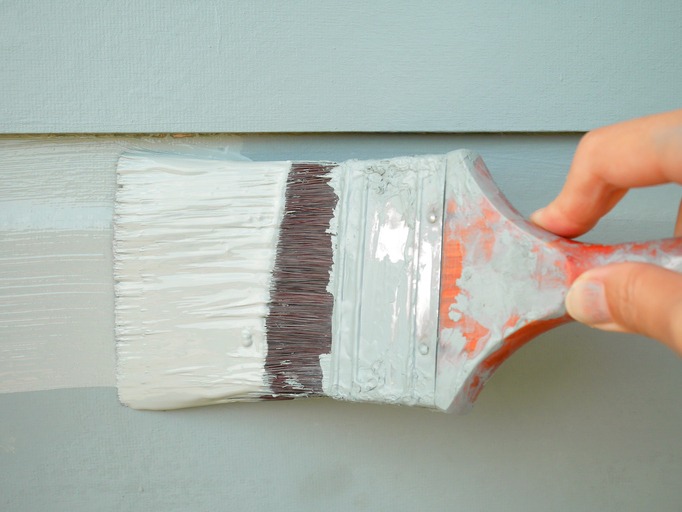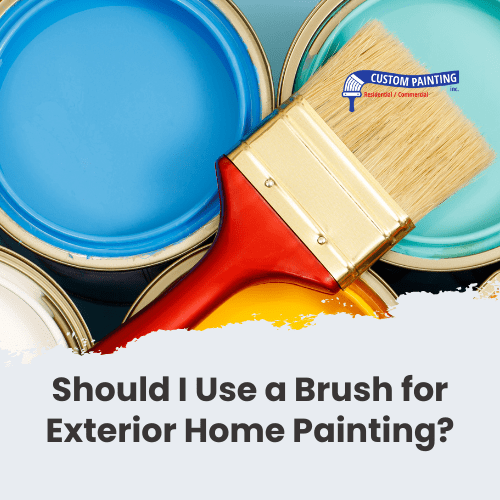When it comes to exterior home painting, choosing the right tools is as important as selecting the perfect color or type of paint. Many homeowners face the decision of whether to use a brush or another method like a roller or sprayer. Each tool offers distinct advantages and challenges, especially in the context of exterior painting, which demands durability and a flawless finish. In this article, we’ll examine the pros and cons of using a brush for your exterior painting projects, helping you make an informed decision on the best approach for painting your home’s facade.
The Advantages of Using a Brush for Exterior Painting
Using a brush for exterior home painting is a method steeped in tradition and backed by several practical advantages. While modern tools like sprayers and rollers can be efficient for large areas, the humble paintbrush offers precision and effectiveness that are hard to match. Here’s a look at the main benefits of choosing a brush for your next exterior painting project:
- Precision and Control: A brush allows for greater control over the application process, making it ideal for detailed work and tricky spots around windows, doors, and trim. This precision ensures that paint is applied exactly where needed without spillage or overspray.
- Effective on Rough Surfaces: Brushes excel at painting on rough or textured surfaces commonly found on exteriors, such as stucco, brick, or wood with visible grain. The bristles can get into crevices and uneven areas, ensuring thorough coverage that rollers or sprayers might miss.
- Economical Paint Usage: When using a brush, you typically use less paint because you have more control over the application. This can lead to significant savings, especially on large projects, as the brush allows you to spread the paint efficiently and evenly.
- Stronger Adhesion: Brush strokes work the paint deeply into the surface, which can enhance adhesion and lead to a more durable finish. This is particularly important for exterior surfaces that endure constant exposure to weather elements.
- No Need for Extensive Prep Work: Unlike spraying, which requires extensive taping and covering to protect surfaces from overspray, painting with a brush minimizes prep time. You can focus on painting rather than setting up and cleaning extensive protective measures.
These advantages make using a brush an excellent choice for those who value meticulousness and durability in their painting projects. While it may require more time and effort compared to other methods, the quality of finish and level of detail achievable with a brush are often worth the extra investment.
The Disadvantages of Using a Brush for Exterior Painting

While using a brush for exterior painting provides great control and detail, it also comes with several disadvantages that might affect your project’s efficiency and outcome. Understanding these drawbacks is crucial for homeowners planning to tackle their painting projects. Here are the main challenges associated with using a brush for exterior painting:
- Time-Consuming Process: Brush painting is a meticulous method that can significantly extend the duration of a painting project. Each stroke is applied manually, which can be labor-intensive and slow, especially for large surface areas like the exterior of a home.
- Physical Fatigue: The physical effort required for brush painting is considerably higher than using a roller or sprayer. Continuous brushing can be taxing on the arms and shoulders, potentially leading to fatigue or strain over prolonged periods, which might affect the consistency and quality of the paint application.
- Uneven Finish: Achieving a uniform coat with a brush requires a lot of skill and patience. It’s easy for inexperienced painters to apply paint unevenly, leading to visible brush marks and an inconsistent finish that may necessitate additional touch-ups or corrective work.
- Limited Coverage: Brushes typically cover less area per stroke compared to rollers or sprayers. This means more time and effort are needed to cover the same amount of surface area, making brush painting less efficient for larger projects.
- Weather Dependency: Brush painting is highly susceptible to weather conditions. Wind can cause dust and debris to stick to wet paint, and sudden rain can wash away partially dried paint. Such factors necessitate careful planning and ideal weather conditions to avoid redoing work.
These disadvantages highlight why brush painting, while effective for detail work and small areas, might not be the best choice for every exterior painting project, especially those that require covering large surfaces or are constrained by tight timelines.
Other Effective Tools for Exterior Home Painting

While a paintbrush is a classic tool for exterior home painting, there are several other effective tools that can make the job quicker, easier, and often more professional. These alternatives each have their own benefits and can be more suitable for different types of painting tasks. Here’s a rundown of other essential tools to consider for your next exterior painting project:
Paint Rollers
Paint rollers are ideal for covering large, flat surfaces quickly and efficiently. They come in various sizes and nap lengths, which can be chosen based on the texture of the surface being painted. For smooth finishes, a shorter nap is best, while rough surfaces like stucco might require a roller with a longer nap. Rollers absorb a lot of paint, reducing the need for frequent reloading, and they spread paint more evenly than brushes, minimizing the likelihood of streaks. This tool is particularly useful for painting large areas like siding or big walls.
Paint Sprayers
A paint sprayer is a powerful tool for covering large areas with an even coat of paint in a fraction of the time it would take with rollers or brushes. Sprayers are particularly effective for reaching difficult or intricate areas, such as shutters and crevices, where brushes and rollers might not perform as well. There are different types of sprayers available, including airless sprayers and HVLP (high volume, low pressure) sprayers, each suitable for different types of paint and finishes. While sprayers can dramatically speed up the painting process, they require careful handling to avoid overspray and uneven coverage.
Paint Edgers
Paint edgers are useful for creating clean lines near trim work, windows, and doors. This tool helps painters achieve a sharp, professional finish without the use of painter’s tape. Edgers are particularly beneficial for tackling the edges of a project, where precision is crucial, and using a large roller or sprayer might result in excess paint application. They come in various designs, some with wheels or guide marks, to help maintain a straight line as you paint.
Extension Poles
For reaching high places without the constant need for ladders, extension poles are invaluable. They can be attached to rollers or certain types of brushes and sprayers to extend your reach. This not only speeds up the painting process by reducing the need to move and readjust a ladder constantly but also enhances safety by keeping the painter on the ground. Extension poles are adjustable, making them versatile for different heights and angles.
Conclusion
Deciding whether to use a brush for exterior home painting involves weighing the precision and control it offers against the time and effort required. While brushes provide excellent detail and strong adhesion, they can also be labor-intensive and less effective over large, flat areas compared to rollers or sprayers. Ultimately, the choice depends on the specific needs of your project, including the type of surfaces to be painted and the desired finish.
For those seeking professional advice or assistance with their exterior painting projects, Custom Painting, Inc. is here to help. You can call us at (925) 294-8062 or fill out a contact form on our website to get started.

